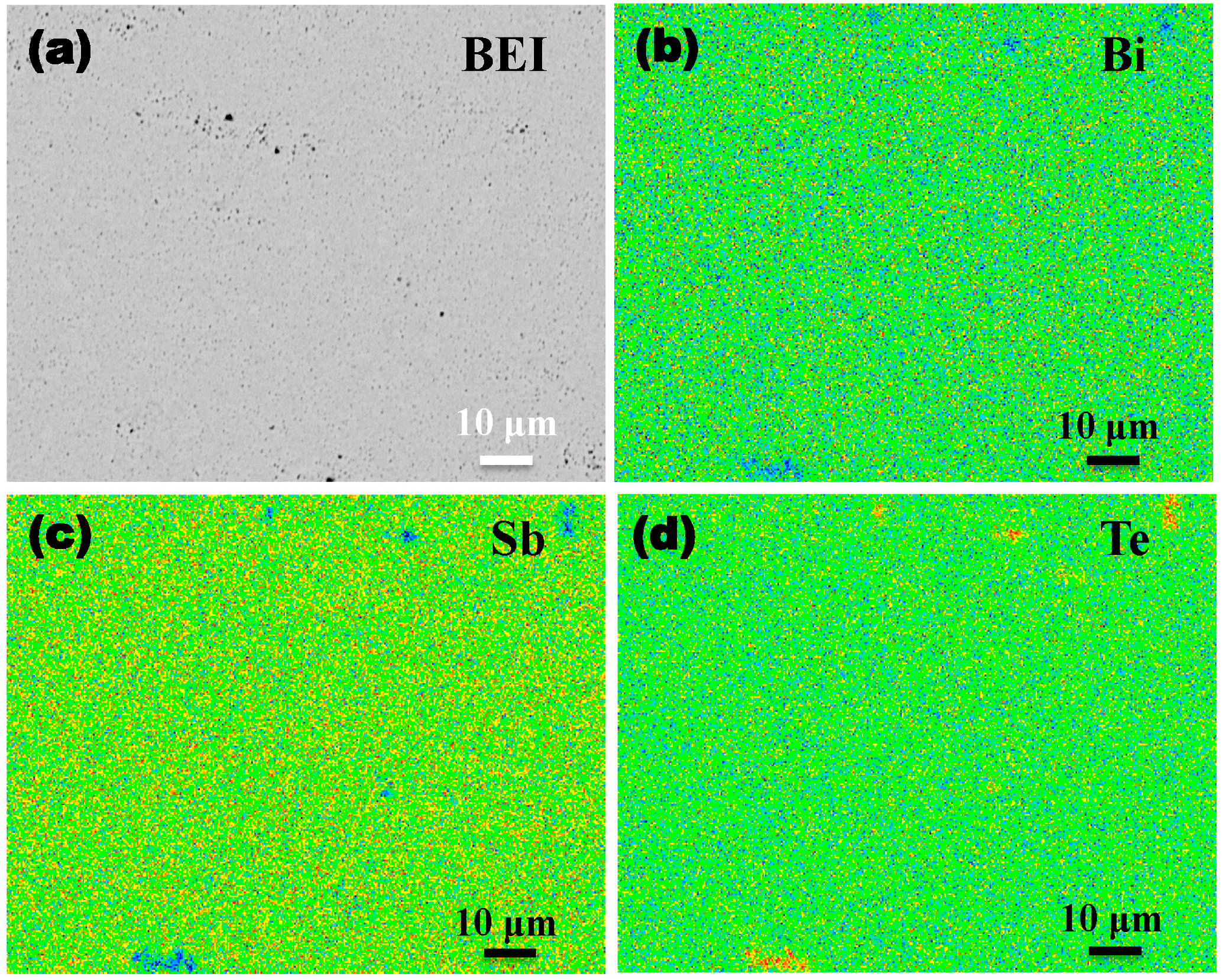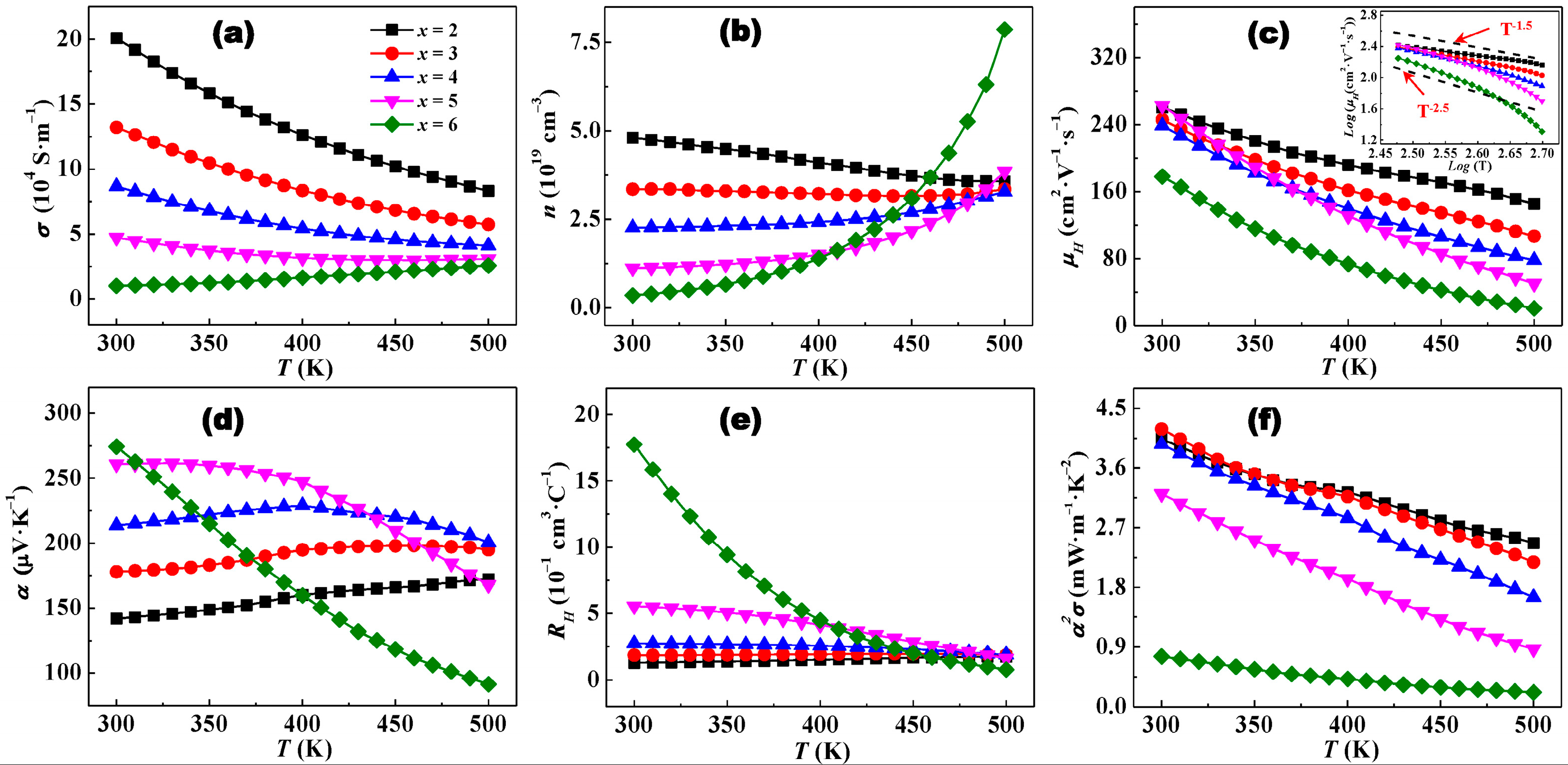Modulation of BixSb2−xTe3 Alloy Application Temperature via Optimizing Material Composition
Abstract
:1. Introduction
2. Experimental Section
3. Results and Discussion
3.1. Composition and Microstructures Analysis
3.2. Thermoelectric Properties
4. Conclusions
Author Contributions
Funding
Institutional Review Board Statement
Informed Consent Statement
Data Availability Statement
Conflicts of Interest
References
- Zheng, Y.; Zhang, Q.; Su, X.L.; Xie, H.Y.; Shu, S.C.; Chen, T.L.; Tan, G.J.; Yan, Y.G.; Tang, X.F.; Uher, C.; et al. Mechanically robust BiSbTe alloys with superior thermoelectric performance: A case study of stable hierarchical nanostructured thermoelectric materials. Adv. Energy Mater. 2014, 5, 1401391. [Google Scholar] [CrossRef]
- Li, L.; Wei, P.; Yang, M.J.; Zhu, W.T.; Nie, X.L.; Zhao, W.Y.; Zhang, Q.J. Strengthened interlayer interaction and improved room-temperature thermoelectric performance of Ag-doped n-type Bi2Te2.7Se0.3. Sci. China Mater. 2023, 66, 3651–3658. [Google Scholar] [CrossRef]
- Zhao, W.Y.; Liu, Z.Y.; Sun, Z.G.; Zhang, Q.J.; Wei, P.; Mu, X.; Zhou, H.Y.; Li, C.C.; Ma, S.F.; He, D.Q.; et al. Superparamagnetic enhancement of thermoelectric performance. Nature 2017, 549, 247–251. [Google Scholar] [CrossRef]
- Ma, S.F.; Li, C.C.; Wei, P.; Zhu, W.T.; Nie, X.L.; Sang, X.H.; Zhan, Q.J.; Zhao, W.Y. High-pressure synthesis and excellent thermoelectric performance of Ni/BiTeSe magnetic nanocomposites. J. Mater. Chem. A 2020, 8, 4816–4826. [Google Scholar] [CrossRef]
- Yi, L.B.; Xu, H.W.; Yang, H.B.; Huang, S.L.; Yang, H.; Li, Y.N.; Zhang, Q.; Guo, Z.; Hu, H.Y.; Sun, P.; et al. Design of Bi2Te3-based thermoelectric generator in a widely applicable system. J. Power Sources 2023, 559, 232661. [Google Scholar] [CrossRef]
- Zhao, L.D.; Dravid, V.P.; Kanatzidis, M.G. The panoscopic approach to high performance thermoelectrics. Energy Environ. Sci. 2014, 7, 251–268. [Google Scholar] [CrossRef]
- He, J.Q.; Girard, S.N.; Kanatzidis, M.G.; Dravid, V.P. Microstructure-Lattice Thermal Conductivity Correlation in Nanostructured PbTe0.7S0.3Thermoelectric Materials. Adv. Funct. Mater. 2010, 20, 764–772. [Google Scholar] [CrossRef]
- Liu, X.D.; Yu, J.C.; Wang, B.; Maji, K.; Alvarez-Ruiz, D.T.; Guilmeau, E.; Freer, R. Enhancing the thermoelectric properties of Nb-doped TiO2-based ceramics through in-situ synthesis of β-Sn inclusions at grain boundaries. J. Eur. Ceram. Soc. 2023, 43, 2523–2533. [Google Scholar] [CrossRef]
- Yu, Y.; He, D.S.; Zhang, S.; Cojocaru Mirédin, O.; Schwarz, T.; Stoffers, A.; Wang, X.Y.; Zheng, S.; Zhu, B.; Scheu, C.; et al. Simultaneous optimization of electrical and thermal transport properties of Bi0.5Sb1.5Te3 thermoelectric alloy by twin boundary engineering. Nano Energy 2017, 37, 203–213. [Google Scholar] [CrossRef]
- Zhang, Q.; Zhai, R.S.; Fang, T.; Xia, K.Y.; Wu, Y.H.; Liu, F.; Zhao, X.B.; Zhu, T.J. Low-cost p-type Bi2Te2.7Se0.3 zone-melted thermoelectric materials for solid-state refrigeration. J. Alloys Compd. 2020, 831, 154732. [Google Scholar] [CrossRef]
- Huang, H.W.; Li, J.; Chen, S.; Zhang, Z.K.; Yan, Y.G.; Su, X.L.; Tang, X.F. Anisotropic thermoelectric transport properties of Bi0.5Sb1.5Te2.96+x zone melted ingots. J. Solid State Chem. 2020, 288, 121433. [Google Scholar] [CrossRef]
- Jiang, J.; Chen, L.D.; Yao, Q.; Bai, S.Q.; Wang, Q. Effect of TeI4 content on the thermoelectric properties of n-type Bi–Te–Se crystals prepared by zone melting. Mater. Chem. Phys. 2005, 92, 39–42. [Google Scholar] [CrossRef]
- Zhu, B.; Wan, W.; Cui, J.; He, J.Q. Point defect engineering: Co-doping synergy realizing superior performance in n-type Bi2Te3 thermoelectric materials. Small 2021, 17, e2101328. [Google Scholar] [CrossRef]
- Hu, L.P.; Meng, F.C.; Zhou, Y.J.; Li, J.B.; Benton, A.; Li, J.Q.; Liu, F.S.; Zhang, C.H.; Xie, H.P.; He, J. Leveraging deep levels in narrow bandgap leveraging deep levels in narrow bandgap Bi0.5Sb1.5Te3 for record-high zTave near room temperature. Adv. Funct. Mater. 2020, 30, 2005202. [Google Scholar] [CrossRef]
- Liu, F.; Zhang, M.; Nan, P.F.; Zheng, X.; Li, Y.Z.; Wu, K.; Han, Z.K.; Ge, B.H.; Zhao, X.B.; Fu, C.G.; et al. Unraveling the origin of donor-like effect in bismuth–telluride-based thermoelectric materials. Small Sci. 2023, 2300082. [Google Scholar] [CrossRef]
- Zhu, Y.K.; Guo, J.; Zhang, Y.X.; Cai, J.F.; Chen, L.; Liang, H.; Gu, S.W.; Feng, J.; Ge, Z.H. Ultralow lattice thermal conductivity and enhanced power generation efficiency realized in Bi2Te2.7Se0.3/Bi2S3 nanocomposites. Acta Mater. 2021, 218, 117230. [Google Scholar] [CrossRef]
- Li, S.; Peng, C.; Wang, C.; Chen, Y.; Li, L.; Yang, G.; Cheng, Z.; Wang, J. In situ generation of flower-like and microspherical dendrites to improve thermoelectric properties of p-type Bi0.46Sb1.54Te3. Mater. Today Phys. 2022, 23, 100633. [Google Scholar] [CrossRef]
- Yang, G.S.; Sang, L.N.; Yun, F.F.; Mitchell, D.R.G.; Casillas, G.; Ye, N.; See, K.; Pei, J.; Wang, X.G.; Li, J.F.; et al. Significant enhancement of thermoelectric figure of merit in BiSbTe-based composites by incorporating carbon microfiber. Adv. Funct. Mater. 2021, 31, 2008851. [Google Scholar] [CrossRef]
- Zhu, T.J.; Xu, Z.J.; He, J.; Shen, J.J.; Zhu, S.; Hu, L.P.; Tritt, T.M.; Zhao, X.B. Hot deformation induced bulk nanostructuring of unidirectionally grown p-type (Bi,Sb)2Te3 thermoelectric materials. J. Mater. Chem. A 2013, 1, 11589. [Google Scholar] [CrossRef]
- Xu, Z.J.; Hu, L.P.; Ying, P.J.; Zhao, X.B.; Zhu, T.J. Enhanced thermoelectric and mechanical properties of zone melted p-type (Bi,Sb)2Te3 thermoelectric materials by hot deformation. Acta Mater. 2015, 84, 385–392. [Google Scholar] [CrossRef]
- Tan, C.; Tan, X.J.; Yu, B.; Liu, G.Q.; Wang, H.X.; Luo, G.Q.; Xu, J.T.; Wu, Q.S.; Liang, B.; Jiang, J. Synergistically optimized thermoelectric performance in Bi0.48Sb1.52Te3 by hot deformation and Cu doping. ACS Appl. Energ. Mater. 2019, 2, 6714–6719. [Google Scholar] [CrossRef]
- Yang, S.E.; Han, H.; Son, J.S. Recent progress in 3D printing of Bi2Te3-based thermoelectric materials and devices. J. Phys. Energy 2024, 6, 022003. [Google Scholar] [CrossRef]
- Hu, Q.J.; Luo, D.; Guo, J.B.; Qiu, W.B. 3D printing of Bi2Te3-based thermoelectric materials with high performance and shape controllability. ACS Appl. Mater. Interfaces 2023, 15, 38623–38632. [Google Scholar] [CrossRef] [PubMed]
- Xie, W.J.; Tang, X.F.; Yan, Y.G.; Zhang, Q.J.; Tritt, T.M. Unique nanostructures and enhanced thermoelectric performance of melt-spun BiSbTe alloys. Appl. Phys. Lett. 2009, 94, 102111. [Google Scholar] [CrossRef]
- Deng, R.G.; Su, X.L.; Hao, S.Q.; Zheng, Z.; Zhang, M.; Xie, H.Y.; Liu, W.; Yan, Y.G.; Wolverton, C.; Uher, C.; et al. High thermoelectric performance in Bi0.46Sb1.54Te3 nanostructured with ZnTe. Energy Environ. Sci. 2018, 11, 1520–1535. [Google Scholar] [CrossRef]
- Zhuang, H.L.; Pei, J.; Cai, B.; Dong, J.F.; Hu, H.H.; Sun, F.H.; Pan, Y.; Snyder, G.J.; Li, J.F. Thermoelectric performance enhancement in BiSbTe alloy by microstructure modulation via cyclic spark plasma sintering with liquid phase. Adv. Funct. Mater. 2021, 31, 2009681. [Google Scholar] [CrossRef]
- Kim, S.; Lee, K.H.; Mun, H.A.; Kim, H.S.; Hwang, S.W.; Roh, J.W.; Yang, D.J.; Shin, W.H.; Li, X.S.; Lee, Y.H.; et al. Dense dislocation arrays embedded in grain boundaries for high-performance bulk thermoelectrics. Science 2015, 348, 109–114. [Google Scholar] [CrossRef]
- Witting, I.T.; Grovogui, J.A.; Dravid, V.P.; Snyder, G.J. Thermoelectric transport enhancement of Te-rich bismuth antimony telluride (Bi0.5Sb1.5Te3+x) through controlled porosity. J. Mater. 2020, 6, 532–544. [Google Scholar] [CrossRef]
- Zhang, C.H.; Maria de la, M.; Li, Z.; Belarre, F.J.; Arbiol, J.; Khor, K.A.; Poletti, D.; Zhu, B.B.; Yan, Q.Y.; Xiong, Q.H. Enhanced thermoelectric performance of solution-derived bismuth telluride based nanocomposites via liquid-phase Sintering. Nano Energy 2016, 30, 630–638. [Google Scholar] [CrossRef]
- Wu, X.K.; Cao, W.; Gu, Y.X.; Wang, Z.Y.; Hou, Y.; Yu, T.; Chen, Z.Q.; Jin, D.; Liu, Y.; Yu, H.Y.; et al. Realizing high thermoelectric performance in Bi0.4Sb1.6Te3 nanosheets by doping Sn element. ACS Appl. Energ. Mater. 2022, 5, 12614–12621. [Google Scholar] [CrossRef]
- Liu, Y.; Zhang, Y.; Ortega, S.; Ibanez, M.; Lim, K.H.; Grau-Carbonell, A.; Marti-Sanchez, S.; Ng, K.M.; Arbiol, J.; Kovalenko, M.V.; et al. Crystallographically textured nanomaterials produced from the liquid phase sintering of BixSb2- xTe3 nanocrystal building blocks. Nano Lett. 2018, 18, 2557–2563. [Google Scholar] [CrossRef] [PubMed]
- Poudel, B.; Hao, Q.; Ma, Y.; Lan, Y.C.; Minnich, A.; Yu, B.; Yan, X.; Wang, D.Z.; Muto, A.; Vashaee, D.; et al. High-thermoelectric performance of nanostructured bismuth antimony telluride bulk alloys. Science 2008, 320, 634–638. [Google Scholar] [CrossRef] [PubMed]
- Liu, D.; Zhu, B.R.; Feng, J.H.; Ling, Y.F.; Zhou, J.; Qiu, G.J.; Zhou, M.H.; Li, J.; Hou, X.F.; Ren, B.G.; et al. High thermoelectric performance of p-Type Bi0.4Sb1.6Te3+x synthesized by plasma-assisted ball milling. ACS Appl. Mater. Interfaces 2022, 14, 54044–54050. [Google Scholar] [CrossRef]
- Pan, Y.; Qiu, Y.; Witting, I.; Zhang, L.G.; Fu, C.G.; Li, J.W.; Huang, Y.; Sun, F.H.; He, J.Q.; Snyder, G.J.; et al. Synergistic modulation of mobility and thermal conductivity in (Bi,Sb)2Te3 towards high thermoelectric performance. Energy Environ. Sci. 2019, 12, 624–630. [Google Scholar] [CrossRef]
- Cai, B.; Zhuang, H.L.; Pei, J.; Su, B.; Li, J.W.; Hu, H.H.; Jiang, Y.L.; Li, J.F. Spark plasma sintered Bi-Sb-Te alloys derived from ingot scrap: Maximizing thermoelectric performance by tailoring their composition and optimizing sintering time. Nano Energy 2021, 85, 106040. [Google Scholar] [CrossRef]
- Liang, H.; Lou, Q.; Zhu, Y.K.; Guo, J.; Wang, Z.Y.; Gu, S.W.; Yu, W.; Feng, J.; He, J.Q.; Ge, Z.H. Highly enhanced thermoelectric and mechanical properties of Bi-Sb-Te compounds by carrier modulation and microstructure adjustment. ACS Appl. Mater. Interfaces 2021, 13, 45589–45599. [Google Scholar] [CrossRef]
- Hu, L.P.; Zhu, T.J.; Liu, X.H.; Zhao, X.B. Point defect engineering of high-performance Bismuth-Telluride-Based thermoelectric materials. Adv. Funct. Mater. 2014, 24, 5211–5218. [Google Scholar] [CrossRef]
- Ma, S.F.; Zeng, L.J.; Du, D.M.; Cao, M.; Lin, M.; Hua, Q.X.; Luo, Q.; Tang, P.; Guan, J.Z.; Yu, J. Grain boundary engineering simultaneously optimized thermoelectric and mechanical properties of BiSbTe alloys. J. Power Sources 2024, 618, 235191. [Google Scholar] [CrossRef]
- Ma, S.F.; Li, C.C.; Cui, W.J.; Sang, X.H.; Wei, P.; Zhu, W.T.; Nie, X.L.; Sun, F.H.; Zhao, W.Y.; Zhang, Q.J. Magneto-enhanced electro-thermal conversion performance. Sci. China Mater. 2021, 64, 2835–2845. [Google Scholar] [CrossRef]





| Samples | μH (cm2/V·s) | nH (1019 cm−3) | α (μV/K) | m*/m0 | Eg (eV) | L (10−8 W·Ω/K2) |
|---|---|---|---|---|---|---|
| Bi0.2Sb1.8Te3 | 260.44 | 4.81 | 141.79 | 1.05 | - | 1.75 |
| Bi0.3Sb1.7Te3 | 245.80 | 3.35 | 178.00 | 1.15 | 0.20 | 1.66 |
| Bi0.4Sb1.6Te3 | 238.62 | 2.27 | 213.64 | 1.21 | 0.18 | 1.60 |
| Bi0.5Sb1.5Te3 | 262.48 | 1.12 | 260.96 | 1.12 | 0.17 | 1.55 |
| Bi0.6Sb1.4Te3 | 177.97 | 0.35 | 274.38 | 0.58 | - | 1.54 |
Disclaimer/Publisher’s Note: The statements, opinions and data contained in all publications are solely those of the individual author(s) and contributor(s) and not of MDPI and/or the editor(s). MDPI and/or the editor(s) disclaim responsibility for any injury to people or property resulting from any ideas, methods, instructions or products referred to in the content. |
© 2024 by the authors. Licensee MDPI, Basel, Switzerland. This article is an open access article distributed under the terms and conditions of the Creative Commons Attribution (CC BY) license (https://creativecommons.org/licenses/by/4.0/).
Share and Cite
Ma, S.; Li, J.; Du, D.; Ruan, X.; Cao, M.; Lin, M.; Hua, Q.; Luo, Q.; Tang, P.; Guan, J.; et al. Modulation of BixSb2−xTe3 Alloy Application Temperature via Optimizing Material Composition. Materials 2024, 17, 5751. https://doi.org/10.3390/ma17235751
Ma S, Li J, Du D, Ruan X, Cao M, Lin M, Hua Q, Luo Q, Tang P, Guan J, et al. Modulation of BixSb2−xTe3 Alloy Application Temperature via Optimizing Material Composition. Materials. 2024; 17(23):5751. https://doi.org/10.3390/ma17235751
Chicago/Turabian StyleMa, Shifang, Jianan Li, Daming Du, Xuefeng Ruan, Ming Cao, Ming Lin, Qiongxin Hua, Qi Luo, Ping Tang, Jinzhao Guan, and et al. 2024. "Modulation of BixSb2−xTe3 Alloy Application Temperature via Optimizing Material Composition" Materials 17, no. 23: 5751. https://doi.org/10.3390/ma17235751
APA StyleMa, S., Li, J., Du, D., Ruan, X., Cao, M., Lin, M., Hua, Q., Luo, Q., Tang, P., Guan, J., & Yu, J. (2024). Modulation of BixSb2−xTe3 Alloy Application Temperature via Optimizing Material Composition. Materials, 17(23), 5751. https://doi.org/10.3390/ma17235751






